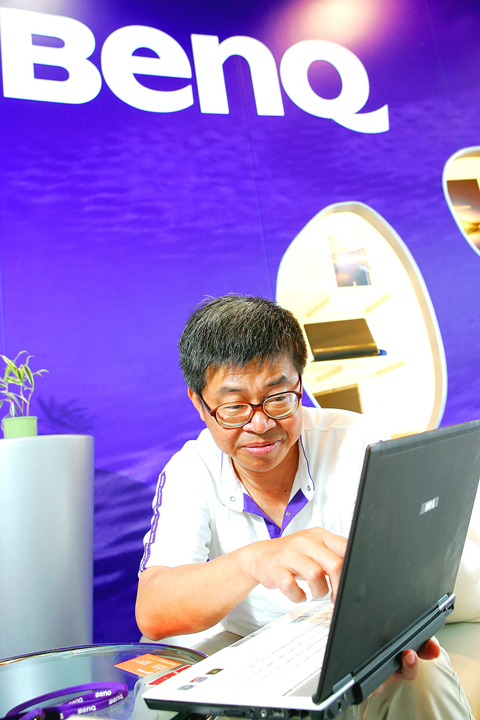BenQ Corp (明基), the branded electronics unit of Qisda Corp (佳世達), said it expects liquid-crystal-display (LCD) television sales to increase tenfold from 2008 in China, their fastest-growing market globally.
The company projects sales of the flat-screen models will rise to 300,000 sets next year from 30,000 last year, Hank Horng (洪漢青), 47, who heads BenQ’s China business, said in an interview at the company’s headquarters in Taipei yesterday. The company is expected to sell 100,000 LCD TVs this year, he said.
BenQ joins Samsung Electronics Co and LG Electronics Inc, the world’s two biggest makers of TVs, in seeking to expand in China, the fastest-growing major economy. The number of LCD TVs sold in China may jump 87 percent to 25 million this year and will probably increase 32 percent next year, DisplaySearch said last month.

PHOTO: BLOOMBERG
“We currently have a small presence in China’s TV market since we’ve only just started, and focus mainly on the eastern China provinces,” Horng said. “We plan to expand into the northern and mid-north of China in the current quarter.”
Qisda climbed 3.7 percent to close at NT$19.85 in Taipei trading. The stock has more than tripled this year, after falling to a record NT$5.17 in November last year. AU Optronics Corp (友達光電), the world’s third-biggest LCD maker in which Qisda owns about a 9 percent stake, declined 0.9 percent to NT$32.55.
“It’s the right strategy to pursue the TV market, since China is poised to become the world’s biggest LCD TV market in the coming years, and everything else in the consumer-electronics sector is either slowing or stagnating,” said Roger Yu (游智超), an analyst at Polaris Securities Co (寶來證券).
DisplaySearch last month raised its full-year estimate for global LCD TV shipments to rise 24 percent to 130 million units, compared with an earlier prediction of 127 million sets, citing demand from China and North America and as more consumers replace their bulkier glass-tube sets.
“Taiwan remains our biggest market for TVs, and we expect China to overtake Taiwan as the biggest market next year,” Horng said. “Our TV sales in China during the eight-day National Day holiday were equivalent to the whole month of sales in September.”
BenQ sells TVs through RT-Mart (大潤發), a hyper-mart owned by Taipei-based Ruentex Industries Ltd (潤泰), in Jiangsu, Zhejiang, Guangdong and Fujian provinces, Horng said. The company will expand its retail business through RT-Mart’s outlets in Shandong, Hunan, Henan and Hebei this quarter, Horng said.

IN THE AIR: While most companies said they were committed to North American operations, some added that production and costs would depend on the outcome of a US trade probe Leading local contract electronics makers Wistron Corp (緯創), Quanta Computer Inc (廣達), Inventec Corp (英業達) and Compal Electronics Inc (仁寶) are to maintain their North American expansion plans, despite Washington’s 20 percent tariff on Taiwanese goods. Wistron said it has long maintained a presence in the US, while distributing production across Taiwan, North America, Southeast Asia and Europe. The company is in talks with customers to align capacity with their site preferences, a company official told the Taipei Times by telephone on Friday. The company is still in talks with clients over who would bear the tariff costs, with the outcome pending further

WEAKER ACTIVITY: The sharpest deterioration was seen in the electronics and optical components sector, with the production index falling 13.2 points to 44.5 Taiwan’s manufacturing sector last month contracted for a second consecutive month, with the purchasing managers’ index (PMI) slipping to 48, reflecting ongoing caution over trade uncertainties, the Chung-Hua Institution for Economic Research (CIER, 中華經濟研究院) said yesterday. The decline reflects growing caution among companies amid uncertainty surrounding US tariffs, semiconductor duties and automotive import levies, and it is also likely linked to fading front-loading activity, CIER president Lien Hsien-ming (連賢明) said. “Some clients have started shifting orders to Southeast Asian countries where tariff regimes are already clear,” Lien told a news conference. Firms across the supply chain are also lowering stock levels to mitigate

NEGOTIATIONS: Semiconductors play an outsized role in Taiwan’s industrial and economic development and are a major driver of the Taiwan-US trade imbalance With US President Donald Trump threatening to impose tariffs on semiconductors, Taiwan is expected to face a significant challenge, as information and communications technology (ICT) products account for more than 70 percent of its exports to the US, Chung-Hua Institution for Economic Research (CIER, 中華經濟研究院) president Lien Hsien-ming (連賢明) said on Friday. Compared with other countries, semiconductors play a disproportionately large role in Taiwan’s industrial and economic development, Lien said. As the sixth-largest contributor to the US trade deficit, Taiwan recorded a US$73.9 billion trade surplus with the US last year — up from US$47.8 billion in 2023 — driven by strong

RESHAPING COMMERCE: Major industrialized economies accepted 15 percent duties on their products, while charges on items from Mexico, Canada and China are even bigger US President Donald Trump has unveiled a slew of new tariffs that boosted the average US rate on goods from across the world, forging ahead with his turbulent effort to reshape international commerce. The baseline rates for many trading partners remain unchanged at 10 percent from the duties Trump imposed in April, easing the worst fears of investors after the president had previously said they could double. Yet his move to raise tariffs on some Canadian goods to 35 percent threatens to inject fresh tensions into an already strained relationship, while nations such as Switzerland and New Zealand also saw increased